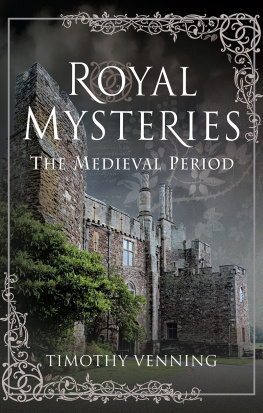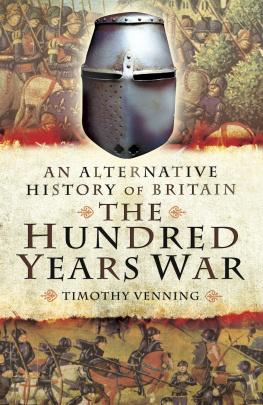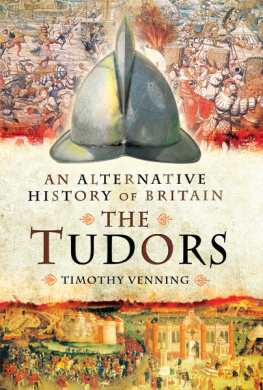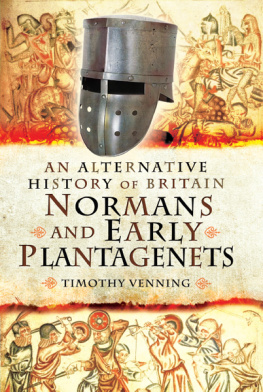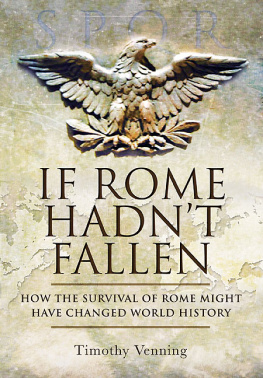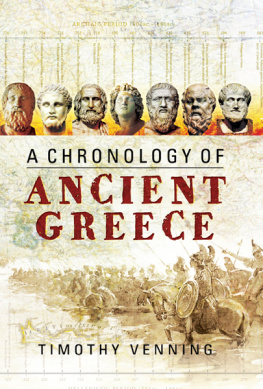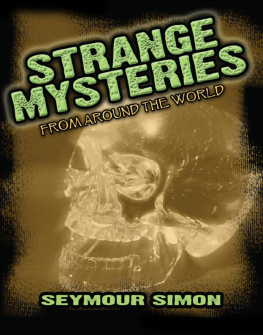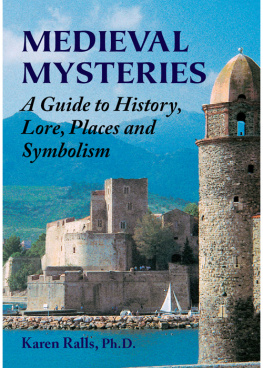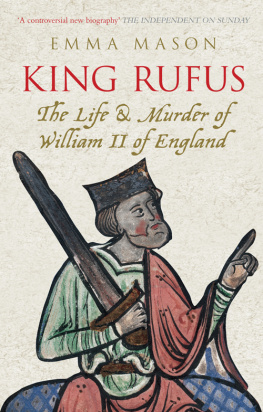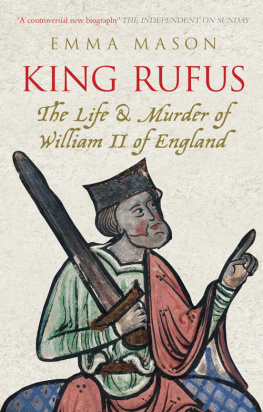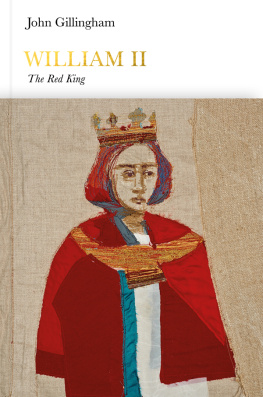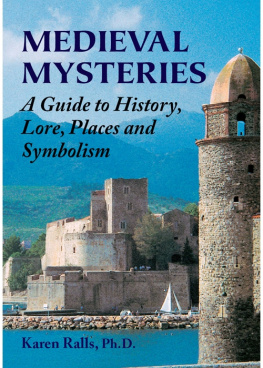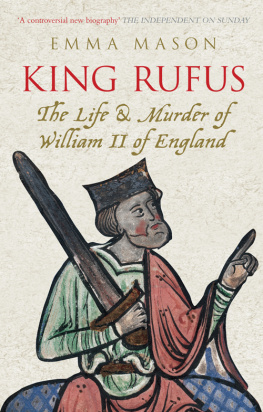Pagebreaks of the print version

Royal Mysteries: The Medieval Period
Royal Mysteries: The Medieval Period
Timothy Venning
First published in Great Britain in 2021 by
Pen & Sword History
An imprint of
Pen & Sword Books Ltd
Yorkshire Philadelphia
Copyright Timothy Venning 2021
ISBN 978 1 52677 962 5
eISBN 978 1 52678 052 2
mobi ISBN 978 1 52678 052 2
The right of Timothy Venning to be identified as Author of this work has been asserted by him in accordance with the Copyright, Designs and Patents Act 1988.
A CIP catalogue record for this book is available from the British Library.
All rights reserved. No part of this book may be reproduced or transmitted in any form or by any means, electronic or mechanical including photocopying, recording or by any information storage and retrieval system, without permission from the Publisher in writing.
Pen & Sword Books Limited incorporates the imprints of Atlas, Archaeology, Aviation, Discovery, Family History, Fiction, History, Maritime, Military, Military Classics, Politics, Select, Transport, True Crime, Air World, Frontline Publishing, Leo Cooper, Remember When, Seaforth Publishing, The Praetorian Press, Wharncliffe Local History, Wharncliffe Transport, Wharncliffe True Crime and White Owl.
For a complete list of Pen & Sword titles please contact
PEN & SWORD BOOKS LIMITED
47 Church Street, Barnsley, South Yorkshire, S70 2AS, England
E-mail:
Website: www.pen-and-sword.co.uk
Or
PEN AND SWORD BOOKS
1950 Lawrence Rd, Havertown, PA 19083, USA
E-mail:
Website: www.penandswordbooks.com
Introduction
T his book will give an account of some of the more famous and less well-known mysteries involving medieval English royalty from 1066 to 1485. This era presents less problems concerning basic data and its probable meaning than the era covered in the first book of the series, on the Anglo-Saxon and early Welsh and Scots kingdoms, but accuracy and a lack of bias are still not to be taken for granted. Medieval kings and their advisers and established institutions such as the Church were as conscious as modern ones of the need for spin making your side of a contentious story was the one accepted as fact. Innuendo, suppressing inconvenient details, and creating fake news were all used as calculated literary weaponry, and a ruler who crossed the Church (as did the oppressive and irreligious William II Rufus and the notorious King John) or was overthrown for incompetence and/or tyranny (such as the controversial Edward II) would be liable to have their reputations trashed. If they lost their thrones their replacements would be keen to have them presented in the worst possible light to justify the revolt, though modern enthusiasm for clearing the names of some of those so treated may have its own problems by letting them off too leniently for genuine crimes. Not all kings went as far as Henry IV did in calling in all the current monastic chronicles for checking after he overthrew his allegedly tyrannical cousin Richard II in 1399, but even if he had favourable references to Richard edited out it does not avoid the fact that the latter was widely deserted by his elite as Henry, a potential heir and rival exiled on dubious grounds, invaded and took his throne.
These problems of interpreting a long-dead rulers character and motives lies at the heart of several of these Royal Mysteries, such as those of the brothers William II and Henry I. Was the first murdered for his throne by the latter in a hunting accident in 1100, or was it just a lucky coincidence that he was shot by a stray arrow while his chosen heir, his elder brother Robert of Normandy, was away on Crusade and unable to stop Henry taking the throne? In the case of the presumed murder of the deposed Edward II, a highly controversial and unpopular ruler overthrown by his wife whose successive male favourites were claimed to be his lovers, he was long assumed to have been killed by agents of either his wife or the latters lover Roger Mortimer in September 1327 according to the wilder rumours in luridly violent circumstances. But members of the inner elite including his half-brother still thought him alive two years later (were they conned and if so by whom?), and centuries later a letter surfaced written to his son Edward III a decade later concerning a mysterious hermit living in Italy who claimed to be Edward II and who the new king seems to have met and not punished. So was Edward II ever killed at all? In the case of his equally controversial, favourite-prone and resented, great-grandson Richard II, also deposed, he too died in suspicious circumstances within months, in February 1400. He was more certainly dead but was it murder or suicide, and what of the well-supported pretenders who claimed to be him? In the still-famous disappearance of the Princes in the Tower, the sons of Edward IV, arguments still rage about whether the late kings brother Richard III had them murdered or not, and if not what happened to them. Passionate legions of Ricardians, with their own modern society set up to defend Richards reputation, still insist that the hitherto honourable and upright strongman of his brothers reign would never have committed the sin of killing his nephews (or other murders alleged to be his responsibility) and he was the victim of unscrupulous smears by his replacement Henry VII.
Thanks to a prolonged campaign of vilification by the Tudor spin machine and the brilliant portrayal of Richard on stage by William Shakespeare over a century later, Richard was unfairly portrayed as a serial killer driven by lust for power, as twisted in character as in his body and the continuing interest in Richard had a new focus when in 2014 his missing remains were discovered under a car-park in Leicester, with a twisted spine from scoliosis which showed that part of the legend was based on fact. In a struggle worthy of a medieval saint, rival cathedrals then fought over where to bury him and the only English king to be denied a State funeral received one over 500 years late. Other royal mysteries included in this book are also connected to the period of the so-called Wars of the Roses and have a bearing on Richards seemingly unlikely claim to the throne, namely the question of whether his brother Edward IV was a bigamist and his marriage to the Princes mother illegal meaning that Richard did have a good claim on the throne. Was Edward IV himself a bastard, or was this just a smear by his enemies? Politics was as full of distortions in the 1480s as in modern times, ruling medieval England was a risky business with kings and ministers alike surrounded by predatory enemies, and what the surviving sources say may be flawed and contain hidden agendas.
As Winston Churchill reminds us with regard to the Second World War, history is written by the winners and can be targeted (or falsified) to be kind to their records and to undermine their rivals. Blatant lies can be successful if the defeated party has no means of getting their own story across. Were the Princes in the Tower really murdered at all or if they were who did it, and was there a chance that some Tudor era pretenders could have been genuine or at least of (illegitimate?) royal blood? Some mysteries have only re-emerged in recent years following the discovery of new or highlighting of long-discarded evidence, such as the presumed death by violence of Edward II at Berkeley Castle in 1327 where some still deny that there is any mystery. Others are still ambiguous because the scanty evidence can be interpreted as either a series of coincidences or as a cover-up of a murky plot, as with the death in a hunting accident of William II in the New Forest in August 1100. Some are reliant on the interpretation of later explanations of what happened by interested parties whose reliability cannot be guaranteed and who had a clear interest in muddying the waters, as with Richard III and his rival Henry VII in the assorted mysteries involving the murder of the Princes and the alleged secret marriage (or legally binding engagement ceremony) of Edward IV and Eleanor Talbot/ Butler. The worst could be believed of celebrities even in the medieval era and even today there are assorted obscure theories floating around regarding a modern sensational royal event, the death of the late Princess of Wales in a midnight car-crash in Paris in August 1997. Conspiracies, coincidences, or cock-ups, this is and always has been a hall of mirrors with distorted reflections.

